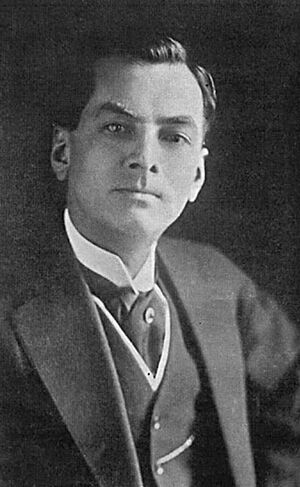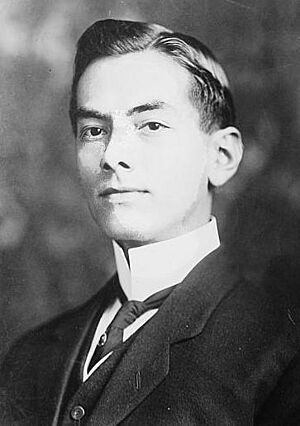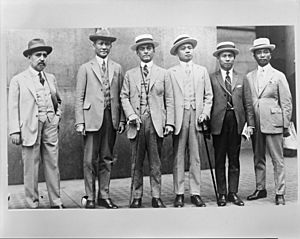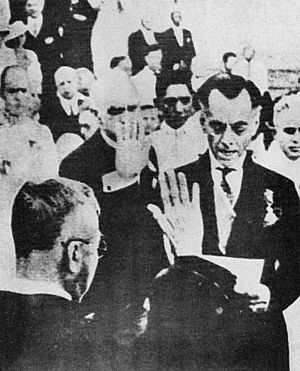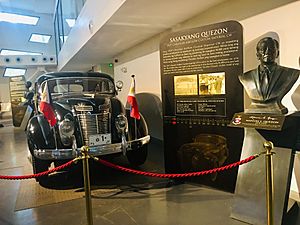Manuel L. Quezon facts for kids
Quick facts for kids
Manuel L. Quezon
GCGH KGCR
|
|
|---|---|

Quezon in November 1942
|
|
| 2nd President of the Philippines | |
| In office 15 November 1935 – 1 August 1944 Serving with Jose P. Laurel (1943–1944)
|
|
| Vice President | Sergio Osmeña |
| Preceded by |
|
| Succeeded by |
|
|
|
| In office 16 July 1941 – 11 December 1941 |
|
| President | Himself |
| Preceded by | Teófilo Sison |
| Succeeded by | Jorge B. Vargas |
| 1st President of the Senate of the Philippines | |
| In office 29 August 1916 – 15 November 1935 |
|
| Preceded by | Position established |
| Succeeded by |
|
| Mayor of Quezon City | |
|
Acting
|
|
| In office 12 October 1939 – 4 November 1939 |
|
| Preceded by | Position established |
| Succeeded by | Tomas Morato |
| Senator of the Philippines from the 5th district | |
| In office 16 October 1916 – 15 November 1935 Serving with
|
|
| Preceded by | Position established |
| Succeeded by | Position abolished |
| Resident Commissioner of the Philippines | |
| In office 23 November 1909 – 15 October 1916 Serving with
|
|
| Preceded by | Pablo Ocampo |
| Succeeded by | Teodoro R. Yangco |
| Assembly Majority Leader | |
| In office 16 October 1907 – 23 November 1909 |
|
| Preceded by | Position established |
| Succeeded by | Alberto Barreto |
| Member of the Philippine Assembly from Tayabas's 1st district | |
| In office 16 October 1907 – 15 May 1909 |
|
| Preceded by | Position established |
| Succeeded by | Filemon Pérez |
| Governor of Tayabas | |
| In office 1906–1907 |
|
| Preceded by | Ricardo G. Parás |
| Succeeded by | Alfredo Castro |
| Member of the Lucena Municipal Council | |
| In office 1906–1906 |
|
| Personal details | |
| Born |
Manuel Luis Quezon y Molina
19 August 1878 Baler, El Príncipe, Captaincy General of the Philippines (now Baler, Aurora, Philippines) |
| Died | 1 August 1944 (aged 65) Saranac Lake, New York, U.S. |
| Cause of death | Tuberculosis |
| Resting place |
|
| Political party | Nacionalista (1907–1944) |
| Spouse | |
| Children | 4 |
| Relatives | Manuel L. Quezon III (grandson) |
| Education | Colegio de San Juan de Letran |
| Alma mater | University of Santo Tomas |
| Signature | |
| Military service | |
| Allegiance |
|
| Branch/service |
|
| Years of service |
|
| Rank | |
| Battles/wars |
|
Manuel Luis Quezon y Molina (born August 19, 1878 – died August 1, 1944) was a very important Filipino leader. He was a lawyer, a soldier, and a politician. He became the first President of the Philippine Commonwealth in 1935 and served until he passed away in 1944.
Quezon was the first Filipino to lead a government for the entire Philippines. Many people consider him the second president of the Philippines, after Emilio Aguinaldo. During his time as president, he worked on many important issues. He helped farmers who didn't own land and improved the country's military defense. He also encouraged development in Mindanao and worked to protect Philippine trade. He tried to make the government fair and honest.
When World War II started and Japan threatened to invade, Quezon set up a government outside the Philippines in the U.S. He died from tuberculosis in New York while in exile. His final resting place is the Quezon Memorial Shrine in Quezon City.
In 2015, Manuel Quezon was honored for helping Jewish people escape the Holocaust between 1937 and 1941. He and the Filipino people received the Wallenberg Medal for their kindness.
Contents
Manuel L. Quezon's Early Life and Career
Manuel Luis Quezon was born on August 19, 1878, in Baler, Aurora. His father, Lucio Quezon, was a teacher and a retired soldier. His mother, María Dolores Molina, was also a teacher. Both his parents taught him, but he also went to a public school set up by the Spanish government. He later studied at the Colegio de San Juan de Letran and finished with high honors.
In 1899, Quezon paused his law studies at the University of Santo Tomas. He joined the fight for Philippine independence. He served as a helper to General Emilio Aguinaldo during the Philippine–American War. He became a Major. After the war, he finished his law studies and became a lawyer in 1903.
He worked as a clerk and surveyor. Then, he joined the government as a prosecutor for Mindoro and Tayabas. He became a council member in Lucena and was elected governor of Tayabas in 1906.
Quezon's Time in Congress
Serving in the House of Representatives (1907–1916)
In 1907, Manuel Quezon was elected to represent his home district of Tayabas in the first Philippine Assembly. This assembly later became the House of Representatives. He quickly became the leader of the majority group. He also led important committees, including the one for rules and the one for money.
From 1909 to 1916, he worked as one of the Philippines' two representatives in the United States House of Representatives. His main goal was to convince the U.S. Congress to pass the Philippine Autonomy Act, also known as the Jones Law. This law would give the Philippines more control over its own government.
Leading the Senate (1916–1935)
Quezon returned to the Philippines in 1916. He was elected as a senator for the Fifth Senatorial District. His fellow senators then chose him to be the President of the Senate of the Philippines. He held this position for 19 years, from 1916 to 1935. This was the longest time anyone had served as Senate President.
He led the first group from the Philippines to the U.S. Congress in 1919. He worked hard to get the Tydings–McDuffie Act passed in 1934. This act set the stage for the Philippines to become independent. In 1922, Quezon became the leader of the Nacionalista Party.
Quezon's Presidency
| Presidential styles of Manuel L. Quezon |
|
|---|---|
 |
|
| Reference style | His Excellency |
| Spoken style | Your Excellency |
| Alternative style | Mr. President |
First Term as President (1935–1941)
In 1935, Quezon won the first national presidential election in the Philippines. He ran with the Nacionalista Party and received almost 68% of the votes. He was sworn in as president in November 1935. He is known as the second President of the Philippines.
Changes in Government and Justice
President Quezon had the power to choose the first all-Filipino cabinet in 1935. Before this, most members of the Supreme Court were Americans. With Quezon, the Supreme Court became fully Filipino. He appointed important people like Claro M. Recto and José P. Laurel to the court.
Quezon wanted "More Government and less politics." He started to reorganize government offices. Some offices were combined, and others were closed. New ones were also created to meet the country's needs. For example, he moved the Philippine Constabulary to the Department of Finance.
Helping People: Social Justice
President Quezon was committed to helping the working class in the Philippines. He started a strong program for social justice. This meant making things fairer for everyone.
- A court was set up to help solve disagreements between workers and employers. This helped prevent strikes.
- A law was passed for a minimum wage, meaning workers had to be paid a certain amount.
- Another law set an eight-hour workday.
- A tenancy law was made for Filipino farmers. This law aimed to improve the relationship between farmers and landowners.
- A Public Defender position was created to help poor people with their legal problems.
Quezon also allowed the government to buy large pieces of land. These lands were then sold cheaply to tenants, so they could own their own land and homes. He also encouraged farmers to work together in cooperatives to earn more money.
Growing the Economy
When the Commonwealth was created, the Philippines' economy was strong. Trade with other countries was at its highest. Exports like crops were in high demand. The government's income also increased a lot.
To keep the economy growing, Quezon created the National Economic Council. This group advised the government on how to improve industries, grow different crops, and manage taxes. They also planned for the future independent Republic of the Philippines.
New agricultural areas were set up, especially in Mindanao. The government helped people move and settle in these areas. A bank was also created to give loans to small farmers. These steps helped improve the country's economy.
Land Reform Challenges
Quezon tried to improve the lives of farmers with the Rice Share Tenancy Act of 1933. This law aimed to make sharing crops between farmers and landowners fairer (50-50). It also limited interest rates on loans and protected farmers from being unfairly kicked off their land.
However, the law had a problem: it only worked if most local councils in a province asked for it. Landowners often controlled these councils, so the law was rarely used. Quezon tried to make it mandatory, but landowners still found ways around it. This meant that many farmers in Central Luzon were still struggling and faced eviction.
Improving Education
President Quezon also focused on education. In 1936, he created the National Council of Education. Money from a new law was used to support public schools across the country. Many new schools were opened to serve more young people. By this time, there were thousands of primary and intermediate schools, and many secondary schools. The government also created an Office of Adult Education.
Women's Right to Vote
President Quezon supported women's suffrage, which is the right for women to vote. The Constitution said that women themselves should decide this. If at least 300,000 women voted yes, they would get the right to vote.

On April 3, 1937, a special vote was held. Many women came out to vote. A total of 447,725 women voted yes, and only 44,307 voted no. Because of this strong support, women in the Philippines gained the right to vote!
Choosing a National Language
Another important decision was about the country's national language. After a year of study, the Institute of the National Language suggested that Tagalog be the basis for the national language. This idea was well-received.
In December 1937, Quezon officially approved this. He declared that the national language would be based on Tagalog and would be adopted in two years. The Institute then started working on a grammar and dictionary for the language.
Government Council and Elections
In 1938, President Quezon expanded the Council of State. This group advised the President and included important leaders like the Vice-President and Senate President.
Elections for the Second National Assembly were held in November 1938. The Nacionalista Party won all 98 seats. The new Assembly focused on laws to make the economy stronger. They also passed a law in 1940 that limited the number of immigrants to 50 per country each year. This law affected Chinese and Japanese people who were escaping war.
In 1940, another vote was held to change the Constitution. These changes brought back a two-house legislature and set the presidential term to four years with one chance for re-election. These changes were strongly approved by the voters.
1941 Presidential Election
Originally, the Constitution did not allow Quezon to run for re-election. But after the changes in 1940, he could run again. In the 1941 presidential election, Quezon was re-elected. He won with almost 82% of the votes.
Second Term and World War II (1941–1944)
Preparing for War
As war grew in the Pacific, the Philippines also got ready. Military training for young people was increased. Blackout drills were held in Manila. First aid was taught in schools. In April 1941, President Quezon created the Civilian Emergency Administration (CEA) to help people during emergencies. Air raid drills were also set up.
Helping Jewish Refugees
In a very kind act, Quezon worked with U.S. High Commissioner Paul V. McNutt to help Jewish refugees. These refugees were escaping harsh rule in Europe. Quezon allowed them to enter the Philippines. He even gave land near his family home to help house them. This showed his great kindness and bravery.
Government in Exile
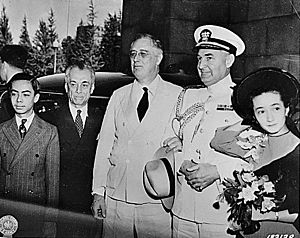
After Japan invaded the Philippines during World War II, President Quezon had to leave. He first went to Corregidor, then to other parts of the Philippines. The U.S. government invited him to go to Australia and then to the United States. There, he set up the Commonwealth government in exile in Washington, D.C.
While in the U.S., he was part of the Pacific War Council. He signed a declaration against the Axis Powers. He also wrote his autobiography, The Good Fight. Despite his poor health, Quezon traveled across the U.S. to give speeches. He wanted to remind Americans about the war in the Philippines and encourage them to help.
Planning for Post-War Philippines
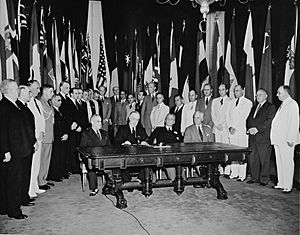
Quezon worked with U.S. President Franklin D. Roosevelt to plan for the Philippines after the war. They discussed creating a group to study the country's economic future. This led to the creation of the Philippine Rehabilitation Commission later on.
Quezon also offered the U.S. Army a Filipino infantry regiment to help with the war effort. He even donated his government's yacht to the United States for war use.
Presidential Succession Issue
By 1943, there was a problem for the Philippine government in exile. According to the Constitution, Quezon's term was supposed to end in December 1943. Vice-President Sergio Osmeña would then become president.
Quezon felt it was not a good time for a change in leadership because of the war. Osmeña agreed to ask the U.S. Congress to pause the rules for presidential succession until the Philippines was free. This plan was approved by the U.S. Senate and House of Representatives in November 1943.
Quezon's Passing

Manuel Quezon suffered from tuberculosis. He spent his last years in hospitals. He passed away on August 1, 1944, in Saranac Lake, New York. He was almost 66 years old.
He was first buried in Arlington National Cemetery in the U.S. After World War II, his body was brought back to Manila in 1946. Finally, on August 1, 1979, his remains were moved to the Quezon Memorial Shrine in Quezon City, where they rest today.
Quezon's Family Life
Manuel Quezon married his first cousin, Aurora Aragón Quezon, on December 17, 1918. They had four children: María Aurora "Baby" Quezon, María Zenaida "Nini" Quezon-Avanceña, Luisa Corazón Paz "Nenita" Quezon, and Manuel L. "Nonong" Quezon, Jr. His grandson, Manuel L. "Manolo" Quezon III, is a well-known writer.
Honors and Legacy of Manuel L. Quezon
Manuel L. Quezon has received many honors both in the Philippines and from other countries.
- Foreign Honors
 France:
France:  : Légion d'honneur, Officier
: Légion d'honneur, Officier Mexico:
Mexico:  : Order of the Aztec Eagle, Collar
: Order of the Aztec Eagle, Collar Belgium:
Belgium:  : Order of the Crown, Grand Cross
: Order of the Crown, Grand Cross Spain:
Spain:  : Orden de la República Española, Grand Cross
: Orden de la República Española, Grand Cross Republic of China:
Republic of China:  : Order of Brilliant Jade, Grand Cordon
: Order of Brilliant Jade, Grand Cordon
- National Honors
 : Order of the Golden Heart, Grand Collar (Maringal na Kuwintas) - given after his death (1960)
: Order of the Golden Heart, Grand Collar (Maringal na Kuwintas) - given after his death (1960) : The Order of the Knights of Rizal, Knight Grand Cross of Rizal (KGCR).
: The Order of the Knights of Rizal, Knight Grand Cross of Rizal (KGCR).- Manuel L. Quezon Day (August 19) is a special holiday in the Philippines, especially in Quezon Province, Aurora, Quezon City, and Lucena City.
Many places and things are named after him:
- Quezon City, Quezon Province, and the Quezon Bridge in Manila.
- The Manuel L. Quezon University.
- The Quezon Service Cross, which is the highest honor given by the Philippines.
- He is featured on the Philippine twenty peso bill and on special one peso coins.
- The "Open Doors" memorial in Israel honors Quezon and Filipinos for saving Jewish refugees.
- Several towns in different provinces are named Quezon.
- His official papers, The Presidential Papers of Manuel L. Quezon, are part of the UNESCO Memory of the World Register.
- Quezon Island in the Hundred Islands National Park is named after him.
Images for kids
Recording of Speech
You can hear a recording of Quezon's voice in a speech called "Message to My People." He gave this speech in English and Spanish. His grandson, Manuel L. Quezon III, said it was recorded in the 1920s when his grandfather was Senate President.
See also
 In Spanish: Manuel L. Quezon para niños
In Spanish: Manuel L. Quezon para niños
- List of Asian Americans and Pacific Islands Americans in the United States Congress
- List of Hispanic Americans in the United States Congress
- First inauguration of Manuel L. Quezon


